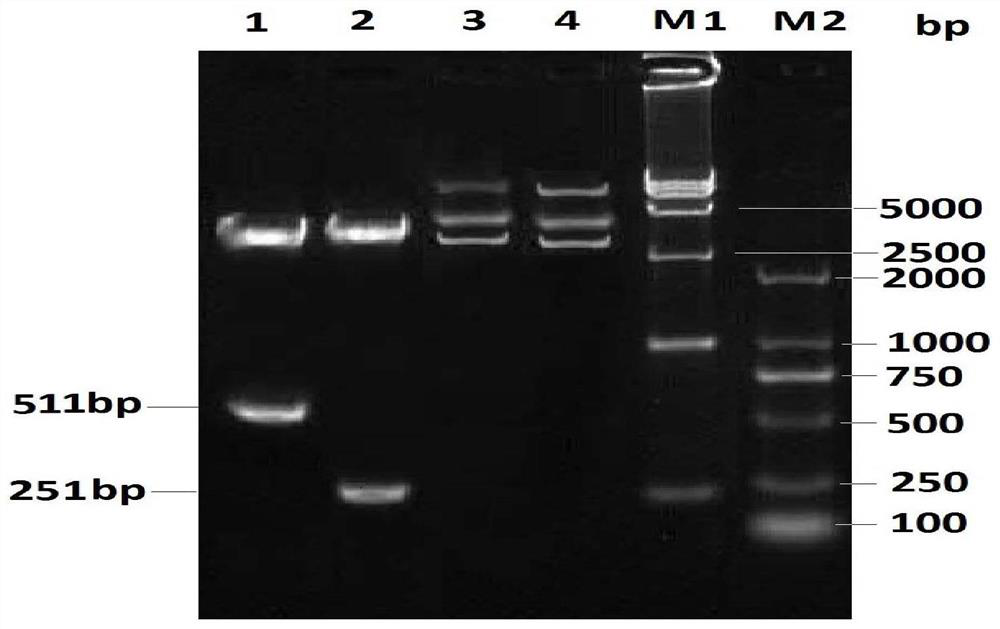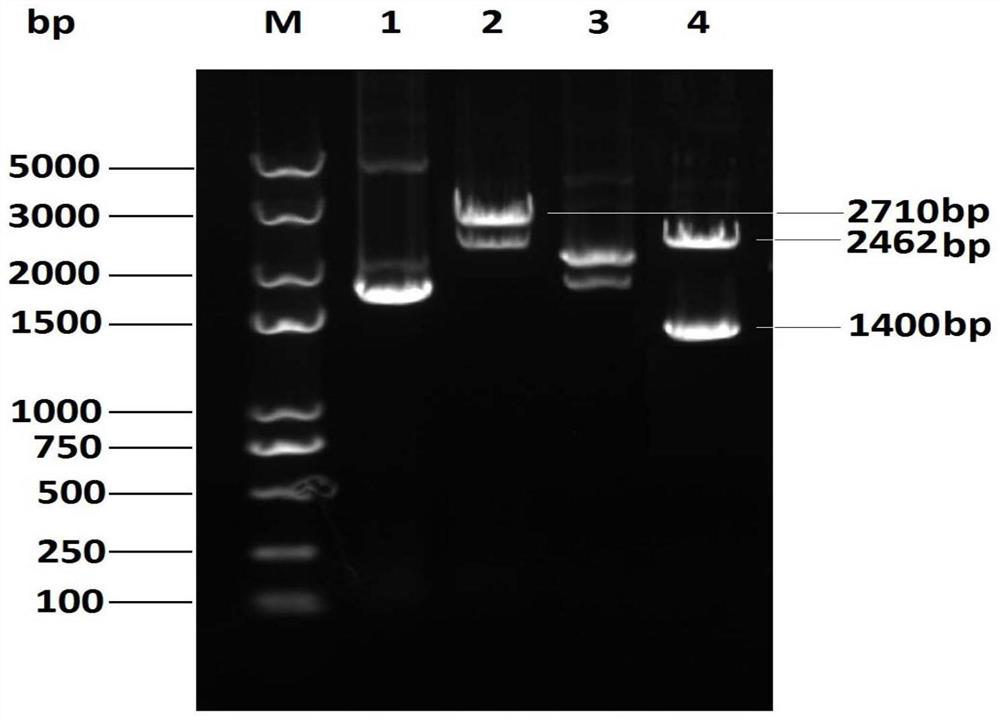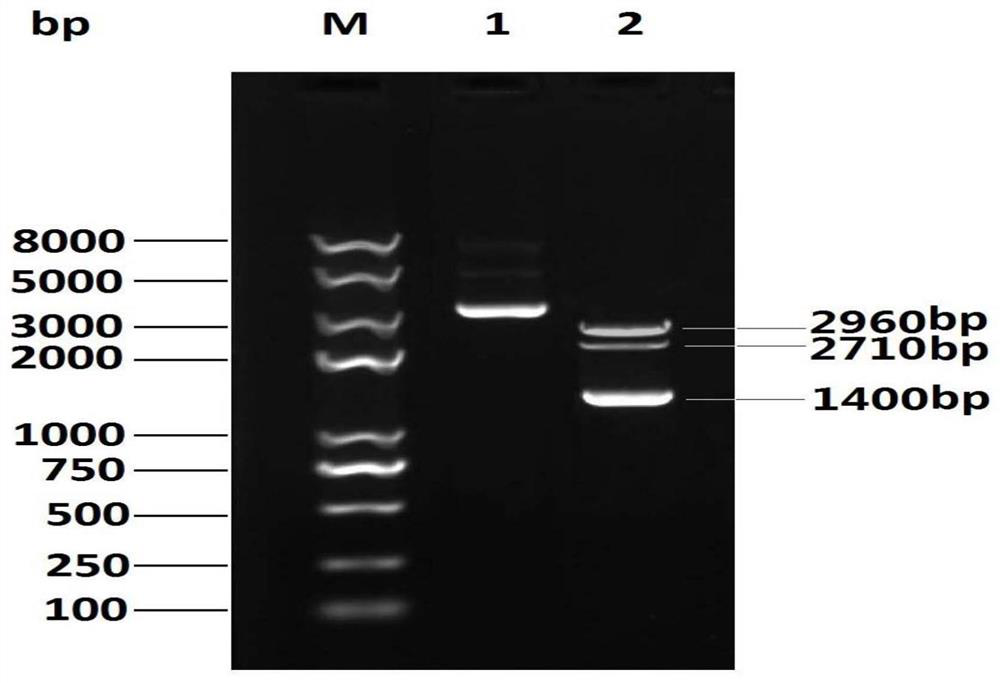Recombinant bovine nodule rash virus for expressing bovine herpesvirus I type gB gene and application of recombinant bovine nodule rash virus
A technology of bovine herpes virus, nodules, applied in the field of recombinant bovine nodular herpes virus
- Summary
- Abstract
- Description
- Claims
- Application Information
AI Technical Summary
Problems solved by technology
Method used
Image
Examples
Embodiment 1
[0054] The preparation of embodiment 1 transfer vector plasmid
[0055] Construction of pSP72-p7.5-gB-TK1 plasmid
[0056] According to the gene sequence of P7.5 and TK1, a restriction site HindIII (AAGCT) was added at the 5' end of the P7.5 promoter, and a restriction site BamH I (GGATC) was added at the 3' end; at the 5' end of TK1 The enzyme cutting site SalII (CCGCGG) is added, and the enzyme cutting site SacII (CCGCGG) is added at the 3' end; P7.5 and TK1 are linked together and artificially synthesized.
[0057] The restriction site BamHI (GGATC) was added to the 5' end of the gB gene, and the restriction site SalII (CCGCGG) was added to the 3' end, which was artificially synthesized.
[0058] The vector pSP72 and P7.5-TK1 were double-enzyme-digested with HindIII and SacII respectively. After the enzyme-digestion was completed, the digestion buffer was removed with a gel recovery kit to obtain linear pSP72 and P7.5-TK1 with restriction sites. Ligate with T4 DNA ligase,...
Embodiment 2
[0068] The preparation of embodiment 2 recombinant bovine nodular rash virus
[0069] Spread LT cells (sheep testicular cells) on a 6-well plate. After the cells grow into a single layer, inoculate the LT cells on the 6-well plate with the attenuated bovine nodular rash strain at a multiplicity of infection (M.O.I.) of 0.1, at 37°C Adsorbed for 2 hours, the prepared recombinant transfer plasmid pB-TK1-gB-p7.5-P11-EGFP-TK2 was transfected by liposome, according to Lipofectamine TM 2000Transfection Reagent kit instruction manual for transfection respectively. Use 2-3 μg of pB-TK1-gB-p7.5-P11-EGFP-TK2 recombinant plasmid per well of cells,
[0070] The amount of liposome used is about 3 times that of DNA (mass volume ratio), and diluted with OPTI-MEM about 100-200 μL. After 48 hours of transfection, observe whether there is fluorescence under a fluorescence microscope, and observe the gradual development of cell lesions at the same time. When 90% of the cells were diseased and...
Embodiment 3
[0073] Domestication of embodiment 3 recombinant bovine nodular herpes virus
[0074] Vero adherent cells were cultured in serum-containing medium after resuscitation, and the amount of serum added was 8%. After 2-3 generations of continuous passage, the serum content began to decrease after the cell proliferation was stable, and 2% serum was reduced for each passage. When the serum concentration After it drops to 5%, add 2% yeast extract and 2% plant hydrolyzed protein to the medium. If the growth is slow, continue to maintain the original serum concentration until the serum content drops to 1%. After the cells grow stably, culture for 1-2 After passage, Vero adherent cells were directly transferred from square flasks to shake flasks for suspension culture. Using serum-free suspension medium, adding 1% yeast extract and 1% plant hydrolyzed protein to the medium, Vero suspension cells were cultured in shake flasks at 1.0×10 6 cells / mL is the initial seeding density, calculate...
PUM
| Property | Measurement | Unit |
|---|---|---|
| Titer | aaaaa | aaaaa |
Abstract
Description
Claims
Application Information
 Login to View More
Login to View More - R&D
- Intellectual Property
- Life Sciences
- Materials
- Tech Scout
- Unparalleled Data Quality
- Higher Quality Content
- 60% Fewer Hallucinations
Browse by: Latest US Patents, China's latest patents, Technical Efficacy Thesaurus, Application Domain, Technology Topic, Popular Technical Reports.
© 2025 PatSnap. All rights reserved.Legal|Privacy policy|Modern Slavery Act Transparency Statement|Sitemap|About US| Contact US: help@patsnap.com



